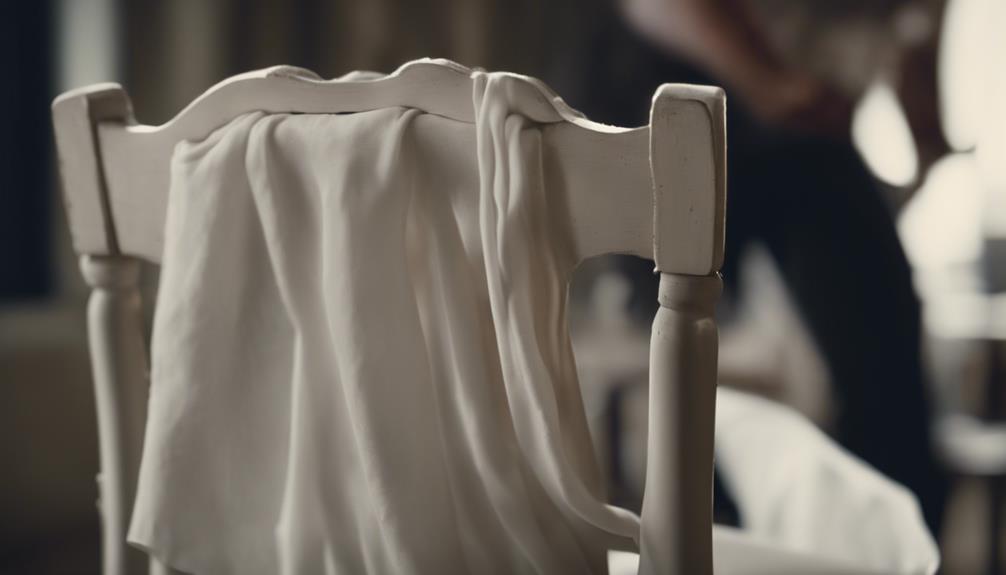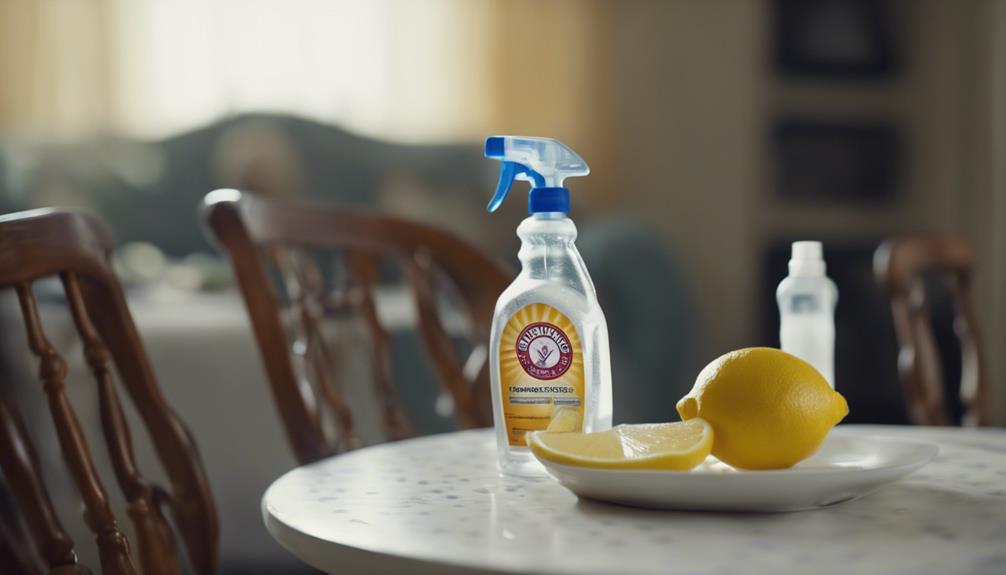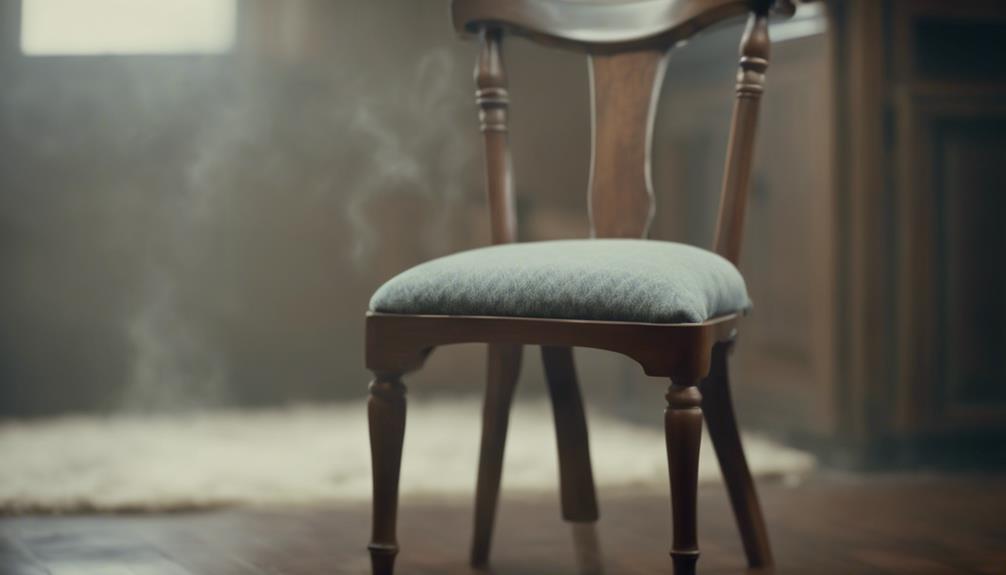To clean dining chair fabric, start by identifying the fabric type. Choose a suitable cleaner based on this type, do a patch test, and adhere to care instructions. Vacuum to remove dirt, then mix a DIY cleaning solution for stains. Use hydrogen peroxide on tougher spots, ensuring the fabric dries completely. Consider deep cleaning with a steamer for a thorough cleanse. These steps will help you achieve a fresh look for your dining chairs. Additional methods addressed in the research can further assist you in maintaining the cleanliness and appearance of your fabric.
Identify Fabric Type
To determine the fabric type of your dining chair, check for a care tag or label attached to the upholstery. Common fabric types for dining chairs may include polyester, linen, velvet, or microfiber.
Identifying the fabric type is important as different materials require specific cleaning methods to avoid damage. For instance, polyester may tolerate gentle cleaning with a mild detergent, while velvet may need a more delicate approach to prevent crushing or matting.
Knowing the fabric type enables you to select the appropriate cleaning products that will effectively remove stains and dirt without harming the upholstery. By understanding the fabric type of your dining chair, you can make sure that your cleaning efforts are both efficient and safe, preserving the quality and appearance of the fabric for years to come.
Choose Appropriate Cleaner
To effectively clean the fabric on your dining chair, start by selecting the right cleaner based on the fabric type. Different fabrics necessitate specific cleaning solutions to guarantee successful results.
Always refer to the care tags or perform a patch test before proceeding with the cleaning process.
Safe Cleaning Products
Consider selecting an appropriate cleaner based on the type of fabric on your dining chair for safe and effective cleaning. Before using any cleaning product, check the care tags on your dining chair or perform a patch test on a hidden area to confirm it won't damage the fabric.
Decipher the care tags to find specific instructions for upholstery cleaning and stain removal. Opt for a cleaner that's formulated for the specific fabric on your dining chair to avoid any potential harm and to achieve the best results.
Always adhere to the manufacturer's care instructions to uphold the quality and longevity of your dining chair fabric. By using safe cleaning products tailored to your fabric type, you can maintain the cleanliness and appearance of your dining chairs without risking damage or discoloration.
Fabric-Specific Care Instructions
Identify the type of fabric on your dining chair to select the suitable cleaner for effective stain removal. Different fabrics necessitate specific cleaning methods, so always refer to the care tags or conduct a test on a small area before proceeding. Care tags are a valuable resource, offering insights into the recommended cleaning process for your dining chair fabric.
For a gentle yet effective cleaning process, consider using a DIY water and soap solution for fabric chairs. When dealing with stubborn stains, hydrogen peroxide can be a useful tool. However, it's essential to test it on a small, inconspicuous area first to prevent any potential damage.
Test Compatibility

Before diving into cleaning your dining chair fabric, it's important to take into account the fabric material, spot test method, and cleaning solution selection. Different fabrics react differently to various cleaners, so always check the care tags or manufacturer's recommendations.
Conduct a spot test on a hidden area to make sure the cleaning solution is compatible with your fabric before proceeding.
Fabric Material Consideration
To guarantee successful cleaning of dining chair fabric, start by determining the type of fabric present to check for compatibility with cleaning products. Check the care instructions or tags provided by the manufacturer to identify suitable cleaning methods.
Different fabric types may require specific cleaning solutions and methods to prevent damage or discoloration. Decipher the care tags to understand the recommended cleaning techniques and products for the particular fabric type.
Testing a small area with the chosen cleaning solution can help assess its effectiveness and safety on the fabric. It's crucial to confirm that the cleaning solution is compatible with the fabric material to avoid ruining the chair's appearance.
Spot Test Method
Check the compatibility of your chosen cleaning solution with the dining chair fabric by conducting a spot test in a concealed area before proceeding with cleaning.
Spot testing is vital to prevent any potential damage or discoloration to the fabric. To perform a spot test, choose a mild cleaning solution and apply a small amount to an inconspicuous area of the chair.
Wait for a few minutes to see if there are any adverse effects such as color bleeding, fading, or texture changes. Different fabrics may react differently to cleaning agents, making this preliminary test essential in ensuring the safety and effectiveness of the cleaning process.
It's a quick and easy way to determine if the cleaning solution is suitable for the specific type of fabric on your dining chair. Remember, always prioritize the well-being of your fabric by taking the time to spot test before proceeding with the overall cleaning process.
Cleaning Solution Selection
Consider evaluating the type of fabric on your dining chair to choose the most suitable cleaning solution for best results. When selecting a cleaning product for your upholstered dining chairs, it's crucial to ensure compatibility with the fabric to avoid any damage.
Here's what you need to do:
- Determine the type of fabric: Different fabrics require specific cleaning solutions, so identify the material of your dining chair upholstery before selecting a cleaner.
- Check the care tags or test the cleaner: Always check the care tags for cleaning instructions or test the cleaning product on a small, inconspicuous area to make sure it won't harm the fabric.
- Use the recommended cleaner: Once you know the type of fabric, use a cleaning solution that's recommended for that specific material to effectively clean the fabric without causing any damage.
Clear Loose Dirt
Start by using a vacuum to clear away any loose dirt on your dining chair fabric to prevent potential stains from setting in.
Regular vacuuming is important to maintain the cleanliness of your dining chairs and prevent dirt accumulation that could lead to stains. By removing loose dirt promptly, you can preserve the appearance and longevity of the fabric on your dining chairs.
Vacuum cleaning is an effective way to prevent dirt from embedding into the fabric and causing unsightly stains. Make it a habit to clear away loose dirt with a vacuum to make sure that your dining chair fabric remains in top condition.
This simple step will help you avoid new stains and keep your dining chairs looking fresh and clean. Remember, prevention is key when it comes to maintaining the cleanliness and quality of your dining chair fabric.
Mix DIY Cleaning Solution

To effectively clean your dining chair fabric, start by mixing a DIY cleaning solution using water and soap. This simple solution is safe for most fabric types and can effectively remove stains from your dining chairs.
Follow these steps to create and apply the DIY cleaning solution:
- Mix Water and Soap: Combine water and a small amount of gentle soap in a bowl to create the cleaning solution.
- Apply to Stained Areas: Dip a clean towel into the DIY solution and gently blot the stained areas on the fabric of your dining chair.
- Test on Small Area: Before applying the solution to the entire stained area, test it on a small, inconspicuous part of the fabric to make sure it doesn't cause any damage.
Regularly using this DIY cleaning solution on your dining chair fabric can help maintain its cleanliness and prevent stubborn stains.
Use Hydrogen Peroxide
For tough stains on your dining chair fabric, employing hydrogen peroxide can be highly effective. Before proceeding, it's crucial to test a small, inconspicuous area to guarantee compatibility.
To begin, grab a clean microfiber towel and dampen it with hydrogen peroxide. Gently blot the stained area, allowing the hydrogen peroxide to sit for a few minutes. This will help break down the stain. Afterward, use a dry microfiber towel to blot off the hydrogen peroxide.
Make sure that the dining chair fabric is completely dry post-treatment for best results. Hydrogen peroxide works effectively to tackle stubborn stains on your chair fabric, but remember to follow the process diligently for the best outcome.
This method can help rejuvenate your dining chair fabric, making it look fresh and clean once more.
Deep Clean With Steamer

Enhance the cleanliness of your dining chair fabric by utilizing a steam cleaner for a thorough deep clean. Steam cleaners are effective at penetrating the fabric fibers, ensuring a deep clean that removes dirt and grime effectively.
Here's how to make the most of this method:
- Penetrating Clean: The steam cleaner's hot steam deeply penetrates the dining chair fabric, loosening and lifting embedded dirt and stains.
- Sanitize Effectively: Steam cleaning not only cleans but also sanitizes the fabric by killing bacteria and germs, making your dining chairs a hygienic place to sit.
- Revive Upholstery: By using a steam cleaner, you can revive the appearance of your dining chair fabric, restoring its freshness and enhancing the overall aesthetic of your dining space.
Remember to allow the fabric to fully dry after steaming to prevent any moisture-related issues and to maintain the integrity of the material.
Conclusion
So there you have it – cleaning dining chair fabric is as easy as pie!
Just remember to treat your fabric with care, like a delicate flower in a garden.
With the right cleaner and a little elbow grease, your dining chairs will be looking fresh and clean in no time.
Happy cleaning!